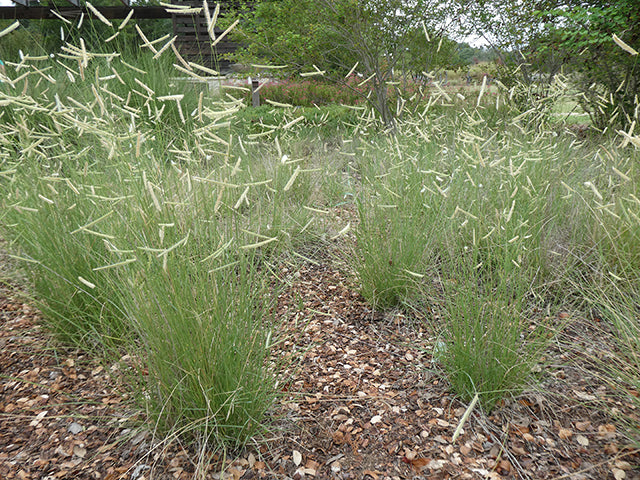Blue Grama (Bouteloua gracilis)
Blue Grama (Bouteloua gracilis)
Low stock: 6 left
Couldn't load pickup availability
Bouteloua gracilis (Willd. ex Kunth) Lag. ex Griffiths
Blue Grama
Poaceae (Grass Family)
Synonym(s): Bouteloua gracilis var. stricta, Bouteloua oligostachya, Chondrosum gracile, Chondrosum oligostachyum
USDA Symbol: BOGR2
USDA Native Status: L48 (N), CAN (N)
Only 12-14 in. in full flower, this is among the shortest of the native ornamental grasses. It is fine-leaved and produces blue-green seedheads which are suspended horizontally like tiny brushes from the tip of each stem. The plant turns tan when dormant. Blue grama grows in bunches in the south, and as a sod-former in the north and at high elevations. It is a perennial.
This is an important, drought-resistant, short grass in the mixed prairies and throughout the Great Plains and the Southwest. It can be confused with Hairy Grama Grass (B. hirsuta), which is distinguished by a sharp point extending beyond the florets. A somewhat similar but shorter species, Buffalograss (B. dactyloides), is usually less than 6 inches (15 cm) high and is typical of dry, short-grass plains. Blue grama is commonly planted as a turfgrass mixed with Buffalograss. Great also for planting in a wildflower meadow and grows easily from seed. One of the most important forage grasses in native ranges.
Plant Characteristics
Habit: Grass/Grass-like
Root Type: Fibrous
Leaf Retention: Deciduous
Leaf Arrangement: Alternate
Leaf Complexity: Simple
Leaf Shape: Linear
Leaf Venation: Parallel
Inflorescence: Spike
Fruit Type: Caryopsis
Size Notes: Foliage normally no more than 4 inches high, seedheads 1 to 2 feet.
Leaf: Gray-Green
Fruit: Bluish green
Bloom Time: Jul , Aug , Sep , Oct
Distribution
USA: AZ , CA , CO , CT , IA , ID , IL , KS , MA , ME , MI , MN , MO , MT , ND , NE , NM , NV , NY , OH , OK , SC , SD , TX , UT , WI , WYCanada: AB , MB , ON , SK
Native Distribution: Western North American from southern Canada to southern Mexico. Western Ontario to Alberta, south through Illinois to western Missouri, Texas, and southern California, through much of Mexico.
Native Habitat: Dry prairies; plains. A dominant grass in dry shortgrass prairies. An understory grass in moister, mixed prairies.
Growing Conditions
Water Use: Low , MediumLight Requirement: Sun
Soil Moisture: Dry
CaCO3 Tolerance: Medium
Drought Tolerance: High
Cold Tolerant: yes
Heat Tolerant: yes
Soil Description: Well-drained, low organic content, gravelly soils or sandy loams, clays. Calcareous or granitic.
Conditions Comments: The most drought-tolerant native turf grass, more so than Buffalograss. Can survive with as little as 7 inches of rain annually. The drier it is, the less likely it will be to form a solid mat by rhizomes; it will stay in separate clumps. For this reason, it is often mixed with Buffalograss and/or wildflowers for a solid cover. The taller you let it grow, the less water it will need, because its roots will be shaded.
Benefit
Use Ornamental: Shortgrass meadow, accent, perennial garden, turfUse Wildlife: Graze, Seeds-granivorous birds
Conspicuous Flowers: yes
Interesting Foliage: yes
Attracts: Birds , Butterflies
Larval Host: Skippers (Garita Skipperling, Uncas Skipper, Pahaska Skipper, Green Skipper, Rhesus Skipper, Simius Roadside-Skipper)
https://www.wildflower.org/plants/result.php?id_plant=BOGR2
Image Information
Photographer: Page, LeeCity: Austin
County: Travis
State: TX
Location Notes: Lady Bird Johnson Wildflower Center.
Accession date: 2022-07-08
Filename: LMP_IMG0542.JPG
Slide Index: P1020044.JPG
Restrictions: Unrestricted
Collection: Wildflower Center Digital Library
Original Format: Digital
Orientation: Landscape
Shot: Flowering plants.
Date Taken: 2019-09-11
NPIN Image Id: 89849


